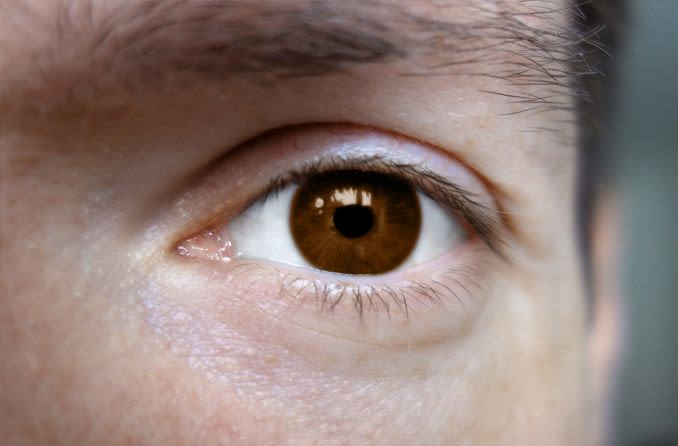I Have to One Eye to See to Read
Refractive errors and refraction: How the eye sees

Blurry vision — unremarkably acquired by refractive errors — is the primary reason a person seeks the services of an center dr..
Just what does it really mean when we're told that our vision is blurry considering we accept a refractive error?
We see the earth around united states because of the manner our optics bend (refract) calorie-free. Refractive errors are optical imperfections that prevent the eye from properly focusing light, causing blurred vision.
The main refractive errors are nearsightedness, farsightedness and astigmatism.
Refractive errors usually tin exist "corrected" with eyeglasses or contact lenses, or they tin can be permanently treated with LASIK and other vision correction surgery (likewise chosen refractive surgery).
Encounter RELATED: What is ametropia?
How light travels through the eye
In lodge to meet, nosotros must take light. While we don't fully sympathise all the different backdrop of light, we practise take an idea of how light travels.
A low-cal ray tin can be deflected, reflected, bent or absorbed, depending on the different substances information technology encounters.
When light travels through h2o or a lens, for instance, its path is bent or refracted. Certain eye structures have refractive properties similar to water or lenses and tin can curve light rays into a precise point of focus essential for sharp vision.
Well-nigh refraction in the centre occurs when light rays travel through the curved, articulate front end surface of the eye (cornea). The eye'south natural lens also bends light rays. Even the tear film on the surface of the center and the fluids within the eye (aqueous sense of humor and vitreous) have some degree of refractive power.
How the eye sees
The procedure of vision begins when light rays that reflect off objects and travel through the eye's optical arrangement are refracted and focused into a point of sharp focus.
For practiced vision, this focus bespeak must be on the retina. The retina is the tissue that lines the inside of the back of the heart, where light-sensitive cells (photoreceptors) capture images in much the same manner that film in a camera does when exposed to light.
These images then are transmitted through the eye's optic nervus to the brain for interpretation.
Just as a photographic camera'southward aperture (called the diaphragm) is used to adjust the amount of lite needed to expose motion-picture show in but the right fashion, the eye'southward pupil widens or constricts to command the amount of light that reaches the retina.
In dark conditions, the pupil widens. In bright weather, the pupil constricts.
Causes of refractive errors
The eye's ability to refract or focus light sharply on the retina primarily is based on three eye anatomy features: 1) the overall length of the eye, 2) the curvature of the cornea and 3) the curvature of the lens inside the eye.
-
Eye length. If the center is too long, low-cal is focused before it reaches the retina, causing nearsightedness. If the eye is besides short, low-cal is non focused by the time it reaches the retina. This causes farsightedness or hyperopia.
-
Curvature of the cornea. If the cornea is not perfectly spherical, and then the epitome is refracted or focused irregularly to create a condition called astigmatism. A person tin can be nearsighted or farsighted with or without astigmatism.
-
Curvature of the lens. If the lens is too steeply curved in relation to the length of the eye and the curvature of the cornea, this causes nearsightedness. If the lens is too flat, the event is farsightedness.
More obscure vision errors, known as higher-order aberrations, also are related to flaws in the fashion calorie-free rays are refracted as they travel through the center's optical organisation.
These types of vision errors, which tin create bug such every bit poor contrast sensitivity, are detected through new technology known as wavefront analysis.
Detection and treatment of refractive errors
Your middle medico determines the blazon and caste of refractive error you have past performing a test called a refraction.
This can be be done with a computerized instrument (automated refraction) or with a mechanical instrument called a phoropter that allows your eye doc to testify you one lens at a fourth dimension (manual refraction).
Often, an automated refraction will exist performed by a fellow member of the physician's staff, and then the centre doctor will refine and verify the results with a transmission refraction.
Your refraction may reveal that you accept more than one type of refractive error. For example, your blurred vision may exist due to both nearsighted and astigmatism.
Your eye doctor will employ the results of your refraction to make up one's mind your eyeglasses prescription.
A refraction, yet, does not provide sufficient information to write a contact lens prescription, which requires a contact lens fitting.
Eyeglass lenses and contact lenses are fabricated with precise curves to refract light to the degree necessary to compensate for refractive errors and bring light to a sharp focus on the retina.
Vision correction surgeries such as LASIK aim to correct refractive errors by changing the shape of the cornea, so that low-cal rays are bent into a more accurate point of focus on the retina.
See an eye doctor
The merely manner to know for sure if you are seeing as clearly every bit possible is to see an eye doctor.
Page published in October 2019
Page updated in February 2022
Source: https://www.allaboutvision.com/eye-exam/refraction.htm
0 Response to "I Have to One Eye to See to Read"
Postar um comentário